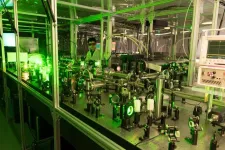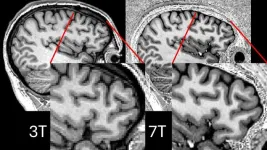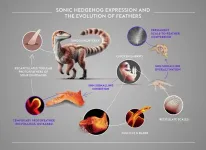(Press-News.org) Men who consistently avoid prostate cancer screening appointments face a disproportionately higher risk of dying from the disease, finds research identifying a new high-risk group.
An analysis of data from across seven countries from the world’s largest prostate cancer screening study, the European Randomized study of Screening for Prostate Cancer (ERSPC), is presented this weekend at the European Association of Urology (EAU) Congress in Madrid.
Prostate cancer is the most common form of cancer in men in 112 countries, with prevalence expected to double by 2040. If introduced on a national scale, prostate cancer screening programmes that measure levels of prostate-specific antigen (PSA) in the blood have the potential to give men earlier access to treatment, a better chance of being cured. They can also prevent costly treatment associated with advanced prostate cancer.
Long-term follow-up data from the ERSPC consistently report that PSA screening programmes can lead to a 20% reduced risk of dying from prostate cancer.
Now, a sub-analysis of 20-year follow-up data from the ERSPC is the first to look at the link between consistently declining screening invitations and the risk of dying from prostate cancer. It reveals a stark contrast that emphasises the potential consequences of avoiding screening. The analysis was led by researchers from the Department of Urology, Erasmus MC Cancer Institute at the University Medical Center Rotterdam, The Netherlands.
Of 72,460 men invited to screening, around one in six men (over 12,400) were non-attenders and skipped every appointment. This group had a 45% higher risk of dying from prostate cancer compared with those who attended screening appointments.
When comparing outcomes with the control group – men who were never invited to screening – men who attended screening appointments had a 23% lower risk of dying from prostate cancer, while non-attenders faced a 39% higher risk of death from the disease.
Deciding not to participate in screening is a choice that may be driven by a complex mix of factors, according to the study’s lead author, Renée Leenen MD, a PhD researcher in the group of Professor Monique Roobol at the Erasmus MC Cancer Institute.
“It may be that men who opted not to attend a screening appointment are care avoiders, meaning they’re less likely to engage in healthy behaviours and preventative care in general. This is the opposite behaviour of people who are perhaps more health conscious and are more likely to attend a screening appointment.
“Our study identifies that men who were invited for screening, but do not attend screening appointments are at significantly higher risk of dying from prostate cancer compared to men who were not offered screening or accepted an invitation for screening. We need to better understand who these men are, why they choose not to attend appointments, and how to motivate them. This will help us to design population-based prostate cancer screening programmes that encourage higher rates of informed participation. Tackling attendance rates in this way could be a big factor in the long-term success of a national prostate screening programme.”
Through the EAU-led PRAISE-U project, several EU countries are working to align approaches to patient-tailored, risk-based population screening programmes for prostate cancer. This latest research highlights the critical issue of attendance if national prostate cancer screening programmes are to be successful, and the need to improve awareness and address inequalities in access to screening for this higher-risk group of men.
The new analysis also suggests that the overall benefit of screening for prostate cancer is higher than previously thought, says Dr Tobias Nordström, Clinical Urologist at the Karolinska Institute in Sweden, and Member of the EAU Scientific Congress Office.
“For countries around Europe that are planning to introduce a national prostate screening programme, this analysis focusing on attendance shows that men who participate in screening have a much-improved long-term benefit than what we’ve seen from previous studies,” he said.
“But it highlights a group of men who need our attention, as they’re more at risk of developing advanced prostate cancer and dying from it. We need to better understand why these men might actively choose not to participate in screening, despite being invited to attend, and how this behaviour is linked to worse outcomes when they get a diagnosis.”
The sub-analysis included 20-year follow-up data from 161,000 men aged 55-69 years in the ERSPC across Finland, the Netherlands, Italy, Sweden, Switzerland, Belgium and Spain. The ERSPC was launched in 1990 across eight European countries, and the full results of this sub-analysis are expected to be published later this year.
END
Worse outcomes for men who avoid prostate cancer screening
Not peer reviewed – Randomised controlled trial - People
2025-03-21
ELSE PRESS RELEASES FROM THIS DATE:
Shrinking Andean glaciers threaten water supply of 90 million people, global policy makers warne
2025-03-21
Shrinking Andean glaciers threaten water supply of 90 million people, global policy makers warned
Shrinking glaciers in the Andes threaten the water supplies of 90 million people
Andean glaciers are thinning by 0.7 metres a year, 35 percent faster than the global average
Climate change is threatening the stability of the Andean glaciers as a water source and the water security of the people who rely on them
Scientists argue we are not doing enough to curb the carbon emissions fueling climate change
Scientists from the University of Sheffield will warn policymakers that the shrinking glaciers of the Andes threaten ...
Women’s earnings fall 10% four years after menopause diagnosis
2025-03-21
Women experience a significant fall in earnings in the years following a menopause diagnosis, with more women stopping work and others working fewer hours, according to a new UCL study published by the Institute for Fiscal Studies.
Economists at UCL, University of Bergen, Stanford University and University of Delaware calculated that women experience a 4.3% reduction in their earnings, on average, in the four years following a menopause diagnosis, with losses deepening to 10% by the fourth year.
This 10% reduction in earnings is approximately half of the estimated 23% loss of earnings experienced by new mothers, also ...
Researchers capture first laser-driven, high-resolution CT scans of dense objects
2025-03-20
A research team led by Colorado State University has achieved a new milestone in 3D X-ray imaging technology. The scientists are the first to capture high-resolution CT scans of the interior of a large, dense object – a gas turbine blade – using a compact, laser-driven X-ray source.
The findings, published this week in Optica, describe the science and engineering behind this new radiographic imaging capability and its potential benefits to a range of industries, from aerospace to additive manufacturing.
The project is a years-long collaboration between researchers at CSU’s Departments ...
Cambridge team uses powerful new MRI scans to enable life-changing surgery in first for adults with epilepsy
2025-03-20
A new technique has enabled ultra-powerful magnetic resonance imaging (MRI) scanners to identify tiny differences in patients’ brains that cause treatment-resistant epilepsy. In the first study to use this approach, it has allowed doctors at Addenbrooke’s Hospital, Cambridge, to offer the patients surgery to cure their condition.
Previously, 7T MRI scanners – so called because they operate using a 7 Tesla magnetic field, more than double the strength of previous 3T scanners – have suffered from signal blackspots in crucial parts of the brain. But in research ...
NRL's narrow field imager launches on NASA's PUNCH mission
2025-03-20
WASHINGTON, D.C. — The U.S. Naval Research Laboratory’s (NRL) Narrow Field Imager (NFI) was launched into space aboard a SpaceX Falcon 9 rocket as a part of NASA’s Polarimeter to Unify the Corona and Heliosphere (PUNCH) mission on March 11 and deployed from Falcon 9 on March 12.
PUNCH is a four-satellite constellation, collecting observations in low Earth orbit. It will conduct global, 3D observations of the inner heliosphere to investigate the solar corona's evolution into the solar wind. The mission is scheduled to conduct science for the next two years, following a 90-day commissioning period.
The NRL-developed NFI, sponsored ...
Galapagos birds exhibit ‘road rage’ due to noise
2025-03-20
A new study has discovered that birds in the Galápagos Islands are changing their behaviour due to traffic noise, with those frequently exposed to vehicles showing heightened levels of aggression.
Published in the journal Animal Behaviour and led by experts from Anglia Ruskin University (ARU) and the Konrad Lorenz Research Centre at the University of Vienna, the research examined the impact of vehicle noise pollution on Galápagos yellow warblers (Setophaga petechia aureola), a songbird widespread on the archipelago.
The Galápagos Islands, ...
Groundbreaking study finds AI-driven interviews with children may boost accuracy in witness accounts
2025-03-20
Groundbreaking Study Finds AI-Driven Interviews with Children May Boost Accuracy in Witness Accounts
In a first-of-its-kind study published in the journal PLOS ONE, an international team of researchers led by scholars from New York University Shanghai and Åbo Akademi University in Turku, Finland explored the potential of artificial intelligence to assist in sensitive child investigative interviews. The study compared how effectively a Large Language Model (LLM), specifically ChatGPT, and untrained human interviewers were able to interview children about a mock event ...
New framework to measure economic well-being considers new and free goods and services; addition of digital goods boosts growth
2025-03-20
Welfare measurement is among the most fundamental questions in economics. Policymakers and others use gross domestic product (GDP) as a proxy for welfare, but this application does not reflect the benefits of introducing new and free goods and services, such as digital goods, and may result in misunderstanding the economy.
In a new study, researchers developed a framework to measure the welfare contributions of new and free goods and services and quantify their benefits. By applying the framework to several examples (e.g., Facebook, Smartphone cameras), the study found that these goods and services significantly increase welfare.
The study ...
Augmented reality guidance for placing intracranial drains now clinically validated
2025-03-20
March 20, 2025 — Placing an external ventricular drain (EVD) at bedside using augmented reality (AR) guidance is more precise than freehand placement and is associated with fewer reinterventions and complications, according to a clinical pilot study of a novel system. Frederick Van Gestel, MD, a neurosurgery resident at Universitair Ziekenhuis Brussel and PhD researcher at Vrije Universiteit Brussel in Brussels, Belgium, and colleagues report first-in-human results in Neurosurgery, the official publication of the Congress ...
How feathers develop in chickens
2025-03-20
Inhibiting the sonic hedgehog (Shh) pathway strongly perturbs feather development in chickens by restricting feather bud outgrowth, invagination and branching, according to a study published March 20th, in the open-access journal PLOS Biology by Rory Cooper and Michel Milinkovitch from the University of Geneva, Switzerland.
Avian feathers are intricate appendages whose forms vary substantially across species and body areas, and between juvenile and adult stages. Understanding both the developmental and evolutionary mechanisms underpinning this morphological diversity has long fascinated biologists. The morphological intricacies ...
LAST 30 PRESS RELEASES:
Making lighter work of calculating fluid and heat flow
Normalizing blood sugar can halve heart attack risk
Lowering blood sugar cuts heart attack risk in people with prediabetes
Study links genetic variants to risk of blinding eye disease in premature infants
Non-opioid ‘pain sponge’ therapy halts cartilage degeneration and relieves chronic pain
AI can pick up cultural values by mimicking how kids learn
China’s ecological redlines offer fast track to 30 x 30 global conservation goal
Invisible indoor threats: emerging household contaminants and their growing risks to human health
Adding antibody treatment to chemo boosts outcomes for children with rare cancer
Germline pathogenic variants among women without a history of breast cancer
Tanning beds triple melanoma risk, potentially causing broad DNA damage
Unique bond identified as key to viral infection speed
Indoor tanning makes youthful skin much older on a genetic level
Mouse model sheds new light on the causes and potential solutions to human GI problems linked to muscular dystrophy
The Journal of Nuclear Medicine ahead-of-print tip sheet: December 12, 2025
Smarter tools for peering into the microscopic world
Applications open for funding to conduct research in the Kinsey Institute archives
Global measure underestimates the severity of food insecurity
Child survivors of critical illness are missing out on timely follow up care
Risk-based vs annual breast cancer screening / the WISDOM randomized clinical trial
University of Toronto launches Electric Vehicle Innovation Ontario to accelerate advanced EV technologies and build Canada’s innovation advantage
Early relapse predicts poor outcomes in aggressive blood cancer
American College of Lifestyle Medicine applauds two CMS models aligned with lifestyle medicine practice and reimbursement
Clinical trial finds cannabis use not a barrier to quitting nicotine vaping
Supplemental nutrition assistance program policies and food insecurity
Switching immune cells to “night mode” could limit damage after a heart attack, study suggests
URI-based Global RIghts Project report spotlights continued troubling trends in worldwide inhumane treatment
Neutrophils are less aggressive at night, explaining why nighttime heart attacks cause less damage than daytime events
Menopausal hormone therapy may not pose breast cancer risk for women with BRCA mutations
Mobile health tool may improve quality of life for adolescent and young adult breast cancer survivors
[Press-News.org] Worse outcomes for men who avoid prostate cancer screeningNot peer reviewed – Randomised controlled trial - People



